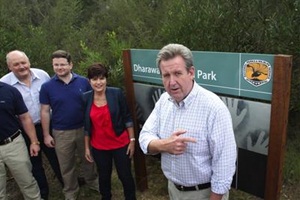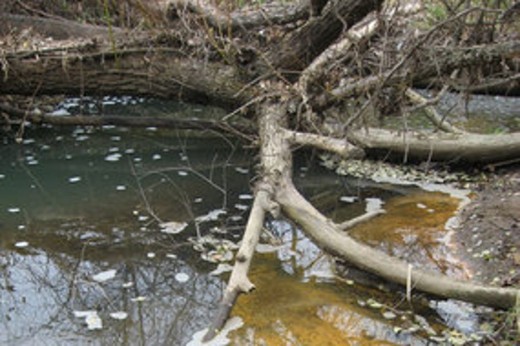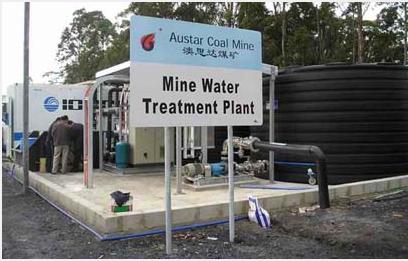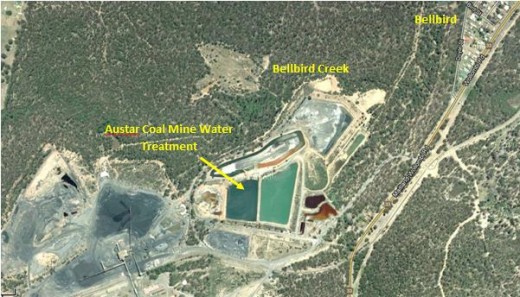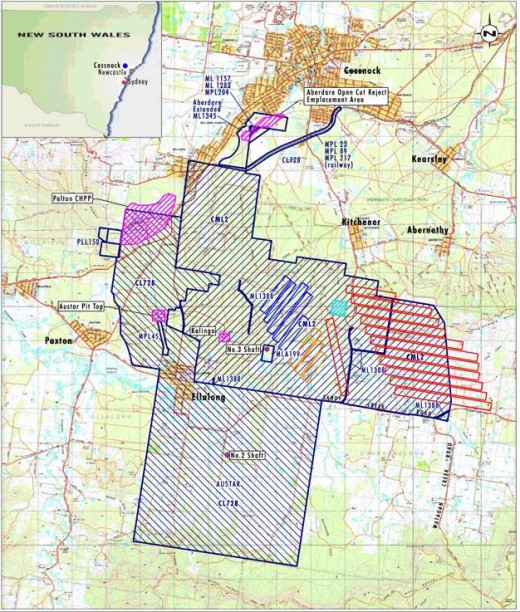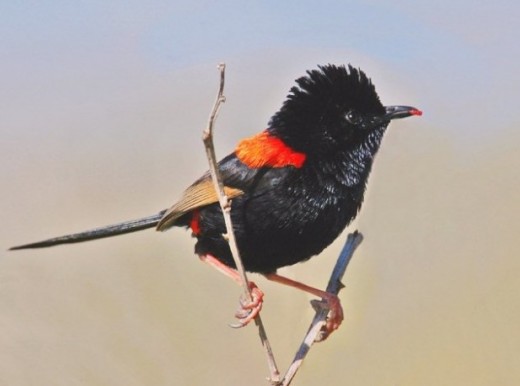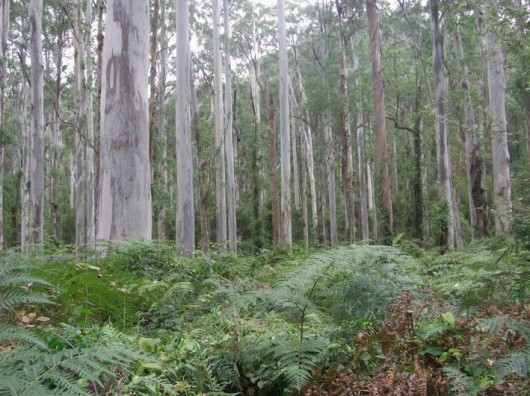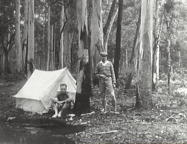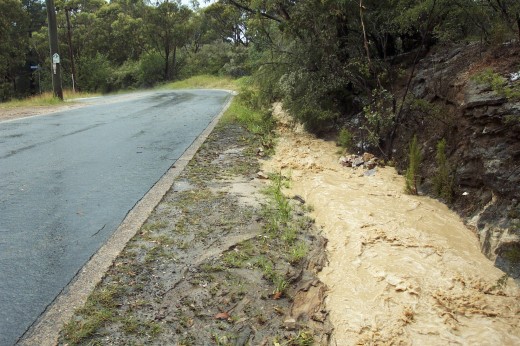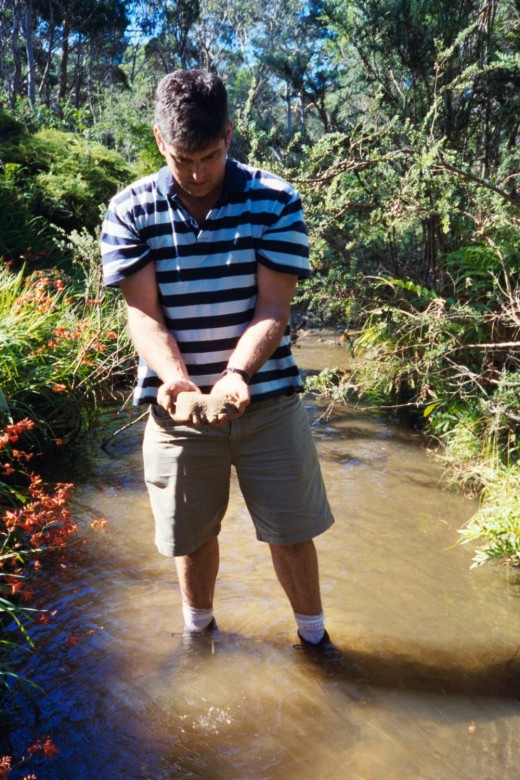EPA: incompetence, neglect and downsizing
Wednesday, July 18th, 2012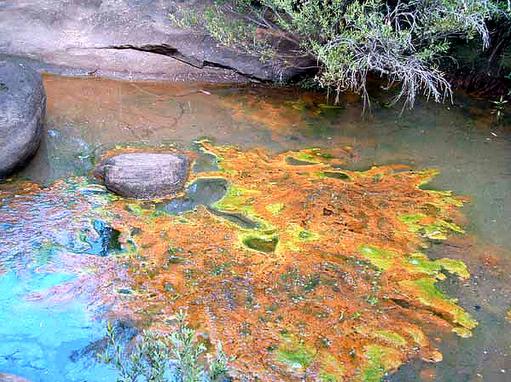 Toxic Omelette killing all life in the Georges River
Toxic Omelette killing all life in the Georges RiverThe EPA in New South Wales (NSW) is accused of ignoring BHP’s coalmine’s toxic contamination of Georges River for over a decade [Source: ‘Coalmine discharge fouls Australia’s Georges River’, by ‘Jim’, 20100803, Desdemona Despair .net, ^http://www.desdemonadespair.net/2010/08/coalmine-discharge-fouls-australias.html]
.
Ed: The Political Climate Change Fad has negated funding of the Environment Protection Authority from critical Pollution Control.
.
 The Upper Georges River
Near the Dharawal National Park, NSW
[Source: ‘Coalmine discharge fouls Georges River’, ^http://off.oatleypark.com/?p=904]
The Upper Georges River
Near the Dharawal National Park, NSW
[Source: ‘Coalmine discharge fouls Georges River’, ^http://off.oatleypark.com/?p=904]
What is the Environmental Protection Authority (EPA) in New South Wales (NSW) doing?
It took an arbitrary bushwalk by a few bushwalkers of the local Macarthur Bushwalkers Club to by chance discover pollution of a remote section of the Georges River down from a coal mine in the Illawarra Region of NSW.
Although they dutifully reported the pollution incident to the NSW EPA, nothing was done, and that was over ten years ago, yet the mine has continued polluting the Georges River.
Labor and Liberal successive NSW Governments have known for more than a decade about this major toxic plume in the Georges River from a coalmine owned by BHP Billiton discharing into the upstream tributary Brennans Creek, but have never pressed the company to stop polluting. Why?
Metals such as zinc, copper, nickel and aluminium, as well as elevated levels of arsenic, are much higher than healthy guidelines, and the contamination has seriously damaged the ecosystem of the river for 15 kilometres downstream from the mine, documents obtained by the Herald show. Environment groups have begun a civil court case against BHP Billiton, which operates the West Cliff coalmine near Campbelltown via a subsidiary company.
.
Ed: This is Australia in 2012, not 1912!
.
The O’Farrell Government‘s Environment Minister, Robyn Parker, said yesterday:
”The EPA needs to lift their game,” Parker said. ”We’ve put them there, and given them increased powers and increased responsibility, and I need to see some action from them.”
Yet on the same day, Parker has hypocritically announced savage staff cuts to the Environment Department. Internal documents circulated among employees said the Department had committed to cutting costs in kangaroo harvesting programs [Ed: poaching wildlife?] , reducing wilderness and wild river assessments, deregulating wildlife licensing where appropriate, scaling back soil and salinity research and ”reducing effort in our biodiversity programs” i.e. ‘frontline services’.
.
Ed: The O’Farrell Government’s Environment Minister, Robyn Parker, has just announced axeing 350 jobs in Environment and Heritage including in the EPA as well as culling many programmes in national parks and animal management, all to save $101 million by 2016. Notably in the O’Farrell Budget 2012-13, the sum of $150,000,000 has been “appropriated to the Treasurer for the recurrent services of the Advance to the Treasurer.” [Clause 18, p16, Budget Paper Appropriation Bill 2012, >Read Bill]
.
Jul 2012: Miner BHP Billiton sued for river pollution by its West Cliff Colliery near Appin
[Source: ‘Regulator ignores toxic plume polluting river for a decade’, 20120718, by Ben Cubby, Environment Editor, Sydney Morning Herald, ^http://www.smh.com.au/environment/conservation/regulator-ignores-toxic-plume-polluting-river-for-a-decade-20120717-228jw.html].
Listed Australian Mining Conglomerate, BHP Billiton at its BHP Billiton’s Illawarra Coal subsidiary ‘Endeavour Coal‘, received a court summons yesterday, but did not respond directly to questions. Instead, it publicised a brief PR legal statement stating: ”The company complies with environmental regulations and is reviewing the details of this matter.”
A string of correspondence between the company and the EPA goes back as far as 2002, and shows that the regulator had been aware of discharges from the mine and some of its environmental impacts for most of that time.
The discharges from the mine flow into Brennans Creek, a tributary of the Georges River, and contain pollution from coal washing, water that has been pumped out of the mine tunnels, and stormwater runoff.
But the matter became public only because bushwalkers noticed the pollution and arranged for independent tests by Ian Wright, an environmental scientist at the University of Western Sydney.
About two years ago Dr Wright took a group of students and some rudimentary laboratory equipment to the river and has since returned many times to check and recheck the results.
”I thought ‘it can’t be as bad as it looks’. But I was wrong about that. You could just see the change in the water,” Dr Wright said. ”It was grey coloured. There was a lot of turbidity and coal ash.”
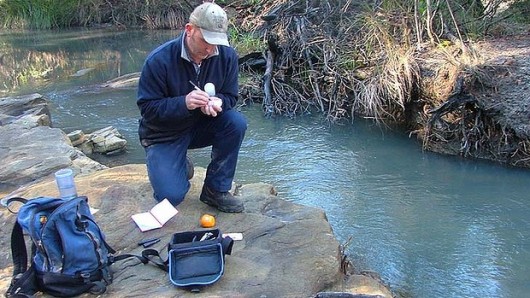 ”I thought ‘it can’t be as bad as it looks”
… UWS Environmental Scientist, Dr Ian Wright.
”I thought ‘it can’t be as bad as it looks”
… UWS Environmental Scientist, Dr Ian Wright.
.
The scientific results showed startling differences from some of the pristine waterways nearby, on the edge of the Dharawal National Park. The aquatic invertebrates – mainly small insects – that form the basis of the food chain were either very scarce or missing altogether.
”It’s knocking around the food chain and the biology in the Georges River,” Dr Wright said.
”Upstream, we’ve got the full complement of invertebrates that you would expect to find. Downstream, there are groups missing and others at very low abundance. The invertebrate data is consistent with a very polluted or degraded waterway.”
The court case is brought by the National Parks Association of NSW and the Macarthur Bushwalkers Club.
Ed: Natural Justice defended not by the EPA, but by the Macarthur Bushwalkers Club (commercial income zero) versus BHP Billiton (commercial income US$37.5 Billion)
.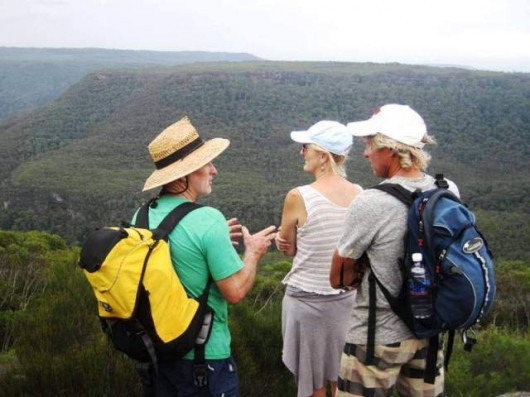 Bushwalkers
Bushwalkers
.
2010: ‘Coalmine discharge fouls Georges River‘
[Source: ‘Coalmine discharge fouls Georges River’, 20100804, by Ben Cubby, Environmental Reporter, Sydney Morning Herald, ^http://www.smh.com.au/environment/coalmine-discharge-fouls-georges-river-20100803-115gr.html; ‘Coalmine discharge fouls Australia’s Georges River’, by ‘Jim’, 20100803, ^http://www.desdemonadespair.net/2010/08/coalmine-discharge-fouls-australias.html].
‘Contaminated water from a coalmine [BHP Billiton’s Endeavour Coal] is flowing into the Georges River, south of Sydney, at levels that are toxic to aquatic life, an independent water quality report has shown.
A plume of saline water stretched along the river for 15 kilometres from the discharge point of an underground mine operated by Endeavour Coal, a subsidiary of BHP Billiton’s Illawarra Coal.
Discharges from Endeavour Coal’s West Cliff Colliery near Appin are ”causing serious water pollution that is very likely to be damaging in-stream ecosystems,” says the report, which was completed on a voluntary basis by researchers from the University of Western Sydney.
But the environmental protection licence for the mine’s wastewater discharge does not limit the amount of saline water that can be flushed into the river.
”I can’t believe that we have put out something called an environment protection licence without any provision to protect the environment,” one of the authors, Dr Ian Wright, a freshwater ecologist at UWS, said. ”Salt at these levels is huge in the context of a river … If you sprayed it on your tomatoes they would wilt.”
The NSW Department of Environment, Climate Change and Water said it was evaluating salt discharge levels that had already been measured by BHP Billiton at the site.
”There is currently no limit for salinity,” a spokesman for the department said. ”However, salinity discharges to Brennans Creek are currently regulated by a staged pollution reduction program under the current environment protection licence.”
When tested last month, the water discharged from the mine was five times more saline than the safe level recommended by the Australian and New Zealand Environment Conservation Council, a standard used by governments to determine water quality for aquatic life. It was nearly 10 times more saline than water in surrounding creeks.
The researchers tested upstream and downstream from the discharge pipe and also the water flowing directly from it.
They concluded that the environmental protection licence ”provides little effective protection to the Georges River” and said it was likely to damage the river’s ecosystems, meaning small invertebrates, fish and related denizens of the local food chain.
The colliery forms part of the company’s proposal to extend a series of coalmines around the township of Appin, so as to be able to extract $2 billion worth of coal a year for 30 years..
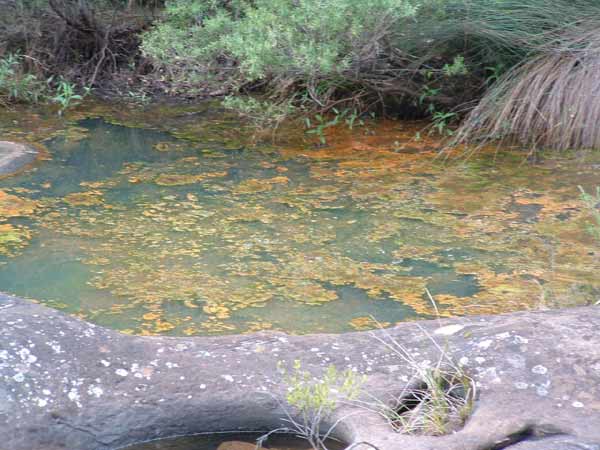 Contamination from coal mining near the Cataract River in Australia, November 2007
[Source: ^http://www.georges-river-macarthur.com/graphics/pollution/05_08.jpg]
Contamination from coal mining near the Cataract River in Australia, November 2007
[Source: ^http://www.georges-river-macarthur.com/graphics/pollution/05_08.jpg]
.
Jan 2011: Meanwhile Barry O’Farrell pledges to Protect Wilderness
[Source: Barry O’Farrell pledges to Protect Wilderness, by Ben Cubby and Sean Nicholls’, 20110108, ^http://www.illawarramercury.com.au/news/local/news/general/barry-ofarrell-pledges-to-protect-wilderness/2041885.aspx?storypage=0]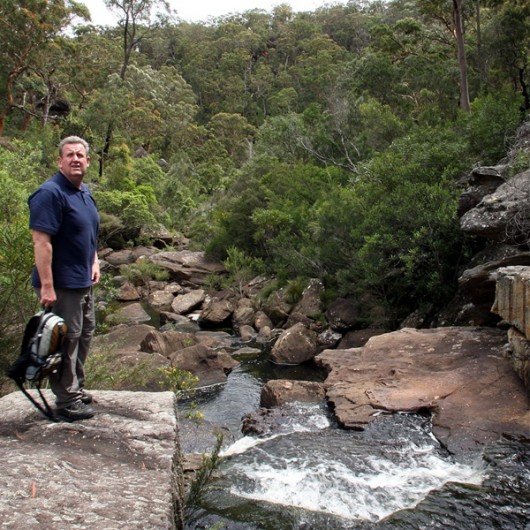 Premier Barry O’Farrell
Next to a watercourse in Dharawal National Park, that flows into the Georges River
Premier Barry O’Farrell
Next to a watercourse in Dharawal National Park, that flows into the Georges River
Jun 2012: O’Farrell now in government: “No deal has been done” with the mining company”
[Source: ‘Sydney snares park conservation event’, by Heath Aston, Merredin Mercury, 20120617, ^http://www.merredinmercury.com.au/news/national/national/general/sydney-snares-park-conservation-event/2592836.aspx].
‘Thousands of hectares of pristine wilderness near Appin, fought over by mining and environment interests for decades, will be saved and opened to the public as a national park if the NSW Coalition wins government in March.
But the announcement, to be made today by Opposition Leader Barry O’Farrell, sets up a potential conflict with BHP Billiton, which still holds the right to mine the billions of dollars worth of coal in the area.
The park, based on the Dharawal State Conservation Area, would add about 6200ha of bushland to the public estate, and provide one of the final pieces to the jigsaw of protected wilderness areas around Sydney.
It is one of the last remaining areas of intact natural bushland near the city, and sits between the Royal National Park and the Blue Mountains World Heritage Area.
Mr O’Farrell said “no deal has been done” with the mining company, which revised plans to mine under the conservation area in October but retains the right to apply again over the 30-year life of its lease.
Mr O’Farrell, who hiked in the area yesterday with environment groups, acknowledged the Coalition would need to enter into discussions about potential compensation.
“We will be having sensible discussion with the relevant stakeholder to get the best outcome for the community,” he said.
“It’s an area that has significant Aboriginal history, it has significant environmental history. It’s accessible, which means … people could go and visit and have access to our great natural environment.”
A peak environment body, the Nature Conservation Council of NSW, and the National Parks Association welcomed the plan.
“We see the Dharawal National Park proposal as an important step towards better conservation in Sydney’s drinking water catchment and beyond,” the council’s director Pepe Clarke said.
Head of the Total Environment Centre Jeff Angel said: “We look forward to more enlightened environment policies from the Coalition and note the new park should be gazetted without a depth restriction in order to protect it from mining.”
A BHP Billiton subsidiary, Illawarra Coal, had planned to dig up $60 billion worth of coal over the next 30 years, much of it from under Dharawal.
The area became the centre of a bitter campaign over reconciling coal mining and clean drinking water catchments. It contains 632 Aboriginal sites, as well as 226 upland swamps filtering water into the Georges River through 46 streams. More than 200 native animal and plant species are found there, including the vulnerable powerful owl, yellow-bellied glider and eastern pygmy possum.
The mining plan was revised in October, after the NSW Planning Assessment Commission released a scathing report into the proposed mine, which was expected to crack the surface of the conservation area and drain some of its water-filtering swamps.
In a landmark review, the commission cited the threat to water catchments and concluded that society would be better off if the coal was left in the ground.
A new plan excluding coal mining under Dharawal and other vulnerable areas is being considered by the Government.
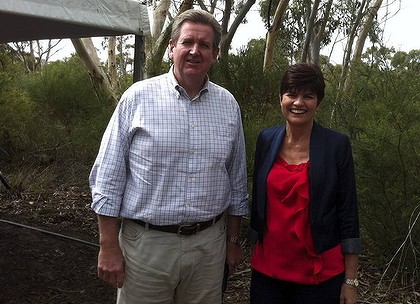 Premier Barry O’Farrell and his Environment Minister Robyn Parker opening Dharawal National Park.
Premier Barry O’Farrell and his Environment Minister Robyn Parker opening Dharawal National Park.
.
Further Reading:
[1] Georges River Macarthur Region, ^http://www.georges-river-macarthur.com/gr_cataract_river.html
.
[2] ‘Dharawal new national park is born’, by Murray Trembath, 20120327, ^http://www.theleader.com.au/news/local/news/environment/dharawal-new-national-park-is-born/2501284.aspx.
[3] Georges River, ^http://www.georgesriver.org.au/.
[4] ‘Parks will go unstaffed as environment jobs slashed’, 20120718, by Ben Cubby and Josephine Tovey, Sydney Morning Herald, ^http://www.smh.com.au/environment/conservation/parks-will-go-unstaffed-as-environment-jobs-slashed-20120717-228cn.html].
.

